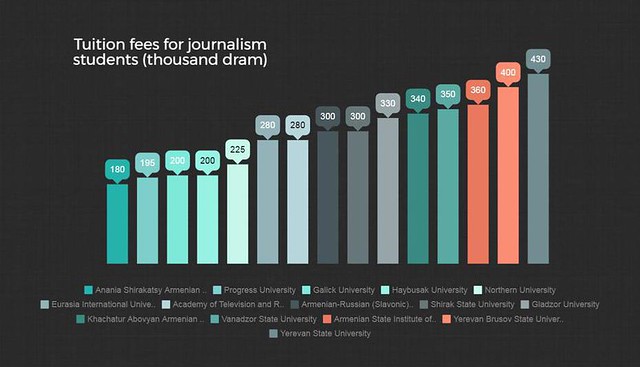This academic year concluded with alarming information: the number of people wishing to enter university has drastically dropped. Vacant spots have remained in many universities and institutes. Universities have begun to be more forgiving toward applicants, so that the drop in paying students will have little impact on the university’s financial situation. Many universities are allowing applicants to retake exams for distance education, which only a few days ago they had deemed unsatisfactory.
The results of universities’ 2017 entrance exams are summed up and the lists made public, but there are vacant spots for many professions.
According to an analysis by the Assessment and Testing Center (ATC), the drop in the number of applicants is mainly due to
- the increase in the number of foreign universities operating in Armenia and the people wishing to study in them
- the increase in the number of people accepted into vocational educational institutions
- the decrease in the population birth rate in the 90s
- emigration (out of Armenia)
Emigration and demographic issues of course play a major role in the drop in university applicants, but a more serious concern is that the education on offer is greater than the demand for it. Which cannot not effect the overall quality of education, since if there’s no competition, striving for quality becomes unnecessary.
Having almost no demand are professions in the basic sciences (physics, chemistry, math, and so on), which are disappearing as fast as Armenia’s scientific thought and the institute-laboratory connection are fading.
But journalism continues to be in demand. Or, in steady demand, as the number of people wanting to be journalists has not been significantly reduced.
According to the Assessment and Testing Center (ATC), 102 people applied to study journalism in 2017, of which 87 were admitted (11 on scholarship; 76 paid).
These are the overall statistics from Yerevan State University, Armenian-Russian (Slavonic) University, Yerevan Brusov State University of Languages and Social Sciences, Gladzor University, Eurasia International University, Haybusak University of Yerevan, and Academy of Television and Radio, included in which are also some universities’ regional branches.
The data provided by ATC allow us to compare the trends of the last few years.
In 2015, the above-mentioned universities received 143 applications, 88 of which were approved (8 on scholarship; 80 paid).
In 2016, there were 100 applications, 87 of which were approved (9 on scholarship; 78 paid).
ATC doesn’t have numbers from the Khachatur Abovyan Armenian State Pedagogical University or the Armenian State Institute of Physical Culture and Sport, since these universities implement their own admissions.
Offering exams independent from the Center are also private institutions: Galick University, Progress University, Northern University, and other educational institutions that also have journalism faculties, streams, and groups.
This year, 9 people applied for the 9 spots in sports journalism at the Armenian State Institute of Physical Culture and Sport. All were admitted.
“At our university, sports journalism isn’t a separate faculty, so there is never a large number of applicants in any given year,” the university’s admissions office tells us.
Of the 20 people who applied to the Armenian State Pedagogical University, 13 were admitted. In the words of the university’s public relations officer, Dianna Markosyan, it’s hard to get admitted into their university, since the committee has a strict requirement with respect to the Armenian language exam.
“Many applicants don’t pass the Armenian language exam, which is why they don’t get the opportunity to take the other two, history of television and radio journalism and general development, exams,” she says.
In 2015, this university had 26 applicants, of which it admitted 21; in 2016, 27 applicants, of which it admitted 15.
Journalism may be considered an easy profession not only because the humanities are always more fluid than exact science, but also because those wanting to become journalists see certain prospects in Armenia.
The chemist and the astronomer will have difficulty finding work, whereas the journalist will perhaps be able to adapt to the market. In any case, many students have similar hopes.
In recent years, universities haven’t noticeably increased the tuition for journalism students.
If they were to increase the tuition, many universities would simply lose potential students. The tuition for future journalists as compared to the faculties of law, languages, finance, or medicine is half as much.
Moreover, tuition for journalism students doesn’t differ that much between private and state universities. It is perhaps for the reason that receiving the most applications for this profession are state institutions, particularly Yerevan State University.

Tuition rates for journalism students fluctuate from 180 to 430 thousand AMD (approximately US$375 to $900).
Gayane Asryan







